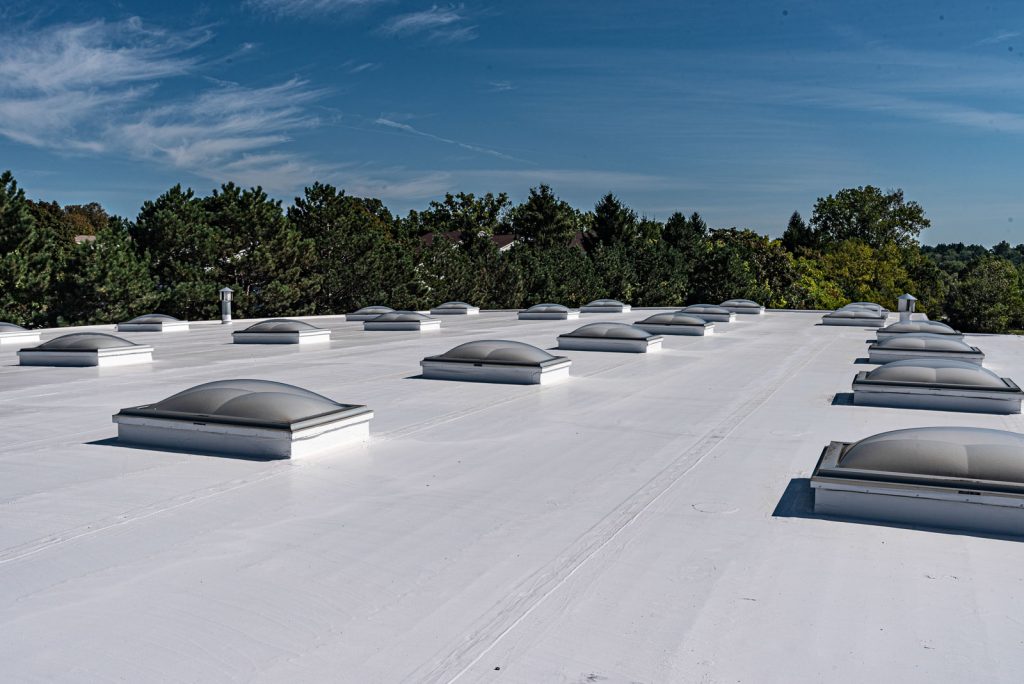When it comes to commercial roofs, there’s no magic bullet to protect them. But if there was, silicone roof coatings would probably come close. These coatings are tough, flexible, and waterproof—basically, the armor your roof needs to handle sun, rain, and everything in between. We sometimes find ourselves both insulating and applying silicone to commercial roofs.
If you’re tired of leaks, high energy bills, and pricey roof replacements, keep reading. We’ll break down what silicone roof coatings are, why they’re worth your attention, and how they might save your building’s roof (and your wallet).
What Are Silicone Roof Coatings, Exactly?

Let’s get this out of the way: silicone roof coatings aren’t magic paint. They’re liquid-applied silicone membranes that bond directly to your existing roof. Once they dry, they form a seamless, waterproof layer that can handle some serious weather.
Why Silicone Roof Coatings Make Sense
If your commercial roof has seen better days, replacing it sounds like a nightmare, doesn’t it? Time, money, and disruption—no one has time for that. But before you break out the checkbook, silicone roof coatings might be the solution. The quality of the coatings is important, which is why we use Gaco coatings. Here’s why:
It’s Waterproof—For Real.
Silicone is like the Teflon of roofing—it doesn’t let water stick around. Unlike other coatings, it holds up even under standing water, which is a game-changer for flat or low-slope roofs.

Save Money Without a Full Roof Replacement.
A full roof tear-off can cost a fortune. Silicone coatings let you avoid that mess. As long as the underlying structure is sound, the coating goes right over your existing roof. Less work, less expense, fewer headaches.
It Handles the Sun Like a Champ.
Roofs take a beating from UV rays, but silicone coatings reflect sunlight instead of absorbing it. That means:
- A cooler building interior.
- Lower energy bills.
- Less wear-and-tear on your HVAC system.
You’ll probably even notice the difference on your electric bill—always a nice bonus.
Flexibility That Won’t Crack.
Temperature swings cause roofs to expand and contract. Over time, that can cause cracks, leaks, and expensive repairs. Silicone coatings are flexible enough to move with your roof, so they won’t split or peel.
Where Can You Use Silicone Roof Coatings?
Silicone coatings work best for commercial or industrial buildings with flat or low-slope roofs. They’re ideal for:
- Metal roofs
- Single-ply membranes (like EPDM or TPO)
- Modified bitumen roofs
- Built-up roofing (BUR)


Basically, if your roof is watertight most of the time but showing its age, silicone coatings are worth looking into.
What’s the Installation Like?
You might think applying silicone roof coatings involves weeks of work and chaos, but it’s surprisingly simple. Here’s how it goes down:
- Inspect the Roof: A thorough check ensures the roof is structurally sound.
- Clean the Surface: Any dirt, debris, or loose material has to go. Power washing is usually the weapon of choice.
- Make Small Repairs: Minor cracks or weak areas are patched up to create a smooth surface.
- Apply the Coating: The silicone coating is sprayed or rolled on evenly across the roof. Once it cures, you’ve got a seamless, waterproof layer.
How Long Do Silicone Roof Coatings Last?
The beauty of silicone coatings is their durability. When applied properly, they can last 20+ years with minimal maintenance. To keep things simple:
- Clean the roof occasionally.
- Have a professional inspect it every couple of years.
- Reapply a fresh layer of silicone when the coating starts wearing thin.
It’s like buying insurance for your roof—only it’s cheaper and actually works.
How Much Does a Silicone Roof Coating Cost?
This is what you really want to know, right? The cost of a silicone roof coating varies depending on:
- The size of the roof
- The condition of the existing surface
- Labor and material costs in your area
On average, you’re looking at $2 to $4 per square foot—significantly less than a full roof replacement. When you factor in energy savings and long-term protection, it’s an investment that pays for itself.
Is a Silicone Roof Coating Right for You?
Here’s a quick way to decide if silicone roof coatings make sense:
- Do you have a flat or low-slope commercial roof?
- Is your roof structurally sound but starting to show wear?
- Are you tired of dealing with leaks, pooling water, and high energy bills?
If you answered “yes” to any of those, it’s time to give silicone coatings some serious thought.
Roofs don’t last forever, but replacing them doesn’t have to be your first move. Silicone roof coatings offer a simple, cost-effective way to protect your building, cut energy costs, and extend your roof’s life.
If you’re ready to stop worrying about leaks and start saving money, reach out to a roofing professional. Silicone coatings might just be the solution you didn’t know you needed.



